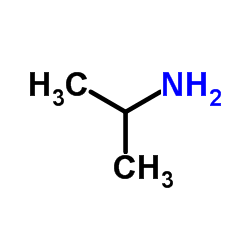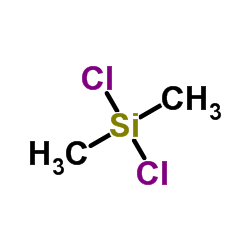6026-42-2
| Name | N-[dimethyl-(propan-2-ylamino)silyl]propan-2-amine |
|---|---|
| Synonyms |
MFCD01861707
EINECS 227-885-8 1,1-Dimethyl-N,N'-diisopropylsilanediamine Bis-isopropylamino-dimethyl-silan |
| Density | 0.812g/cm3 |
|---|---|
| Boiling Point | 148ºC |
| Molecular Formula | C8H22N2Si |
| Molecular Weight | 174.35900 |
| Flash Point | 50.1ºC |
| Exact Mass | 174.15500 |
| PSA | 24.06000 |
| LogP | 2.46600 |
| Index of Refraction | 1.411-1.415 |
Synonym: Section 2 - COMPOSITION, INFORMATION ON INGREDIENTS
Risk Phrases: 36/37/38 Section 3 - HAZARDS IDENTIFICATION EMERGENCY OVERVIEW
Irritating to eyes, respiratory system and skin. Potential Health Effects Eye: Causes eye irritation. May cause conjunctivitis. Contact with the eyes may cause corneal damage. Skin: Causes skin irritation. May be harmful if absorbed through the skin. Ingestion: May cause irritation of the digestive tract. Causes gastrointestinal irritation with nausea, vomiting and diarrhea. May be harmful if swallowed. Ingestion causes severe burns of the mouth and stomach. Inhalation: Causes respiratory tract irritation. May cause lung damage. May be harmful if inhaled. Chronic: Not available. Section 4 - FIRST AID MEASURES Eyes: Flush eyes with plenty of water for at least 15 minutes, occasionally lifting the upper and lower eyelids. Get medical aid. Skin: Get medical aid. Flush skin with plenty of water for at least 15 minutes while removing contaminated clothing and shoes. Ingestion: Get medical aid. Wash mouth out with water. Inhalation: Remove from exposure and move to fresh air immediately. If not breathing, give artificial respiration. If breathing is difficult, give oxygen. Get medical aid. Notes to Physician: Section 5 - FIRE FIGHTING MEASURES General Information: As in any fire, wear a self-contained breathing apparatus in pressure-demand, MSHA/NIOSH (approved or equivalent), and full protective gear. Extinguishing Media: Use carbon dioxide or dry chemical. Section 6 - ACCIDENTAL RELEASE MEASURES General Information: Use proper personal protective equipment as indicated in Section 8. Spills/Leaks: Absorb spill with inert material (e.g. vermiculite, sand or earth), then place in suitable container. Section 7 - HANDLING and STORAGE Handling: Avoid breathing dust, vapor, mist, or gas. Avoid contact with skin and eyes. Use only in a chemical fume hood. Storage: Store in a cool, dry place. Store in a tightly closed container. Section 8 - EXPOSURE CONTROLS, PERSONAL PROTECTION Engineering Controls: Use adequate ventilation to keep airborne concentrations low. Exposure Limits CAS# 6026-42-2: Personal Protective Equipment Eyes: Not available. Skin: Wear appropriate protective gloves to prevent skin exposure. Clothing: Wear appropriate protective clothing to prevent skin exposure. Respirators: Follow the OSHA respirator regulations found in 29 CFR 1910.134 or European Standard EN 149. Use a NIOSH/MSHA or European Standard EN 149 approved respirator if exposure limits are exceeded or if irritation or other symptoms are experienced. Section 9 - PHYSICAL AND CHEMICAL PROPERTIES Physical State: Clear liquid Color: colorless Odor: amine-like pH: Not available. Vapor Pressure: Not available. Viscosity: Not available. Boiling Point: Not available. Freezing/Melting Point: Not available. Autoignition Temperature: Not available. Flash Point: Not available. Explosion Limits, lower: Not available. Explosion Limits, upper: Not available. Decomposition Temperature: Solubility in water: Reacts. Specific Gravity/Density: Molecular Formula: C8H20Si Molecular Weight: 144.2255 Section 10 - STABILITY AND REACTIVITY Chemical Stability: Stable. Conditions to Avoid: Incompatible materials, excess heat. Incompatibilities with Other Materials: Water, oxidizing agents, acids, bases, alcohols, aluminum, copper, chlorates, zinc. Hazardous Decomposition Products: Carbon monoxide, carbon dioxide, silicon dioxide. Hazardous Polymerization: Has not been reported Section 11 - TOXICOLOGICAL INFORMATION RTECS#: CAS# 6026-42-2 unlisted. LD50/LC50: Not available. Carcinogenicity: Di(isopropylamino)dimethylsilane - Not listed by ACGIH, IARC, or NTP. Section 12 - ECOLOGICAL INFORMATION Section 13 - DISPOSAL CONSIDERATIONS Dispose of in a manner consistent with federal, state, and local regulations. Section 14 - TRANSPORT INFORMATION IATA No information available. IMO No information available. RID/ADR No information available. Section 15 - REGULATORY INFORMATION European/International Regulations European Labeling in Accordance with EC Directives Hazard Symbols: XI Risk Phrases: R 36/37/38 Irritating to eyes, respiratory system and skin. Safety Phrases: S 26 In case of contact with eyes, rinse immediately with plenty of water and seek medical advice. S 37/39 Wear suitable gloves and eye/face protection. WGK (Water Danger/Protection) CAS# 6026-42-2: No information available. Canada CAS# 6026-42-2 is listed on Canada's DSL List. CAS# 6026-42-2 is not listed on Canada's Ingredient Disclosure List. US FEDERAL TSCA CAS# 6026-42-2 is listed on the TSCA inventory. SECTION 16 - ADDITIONAL INFORMATION N/A |
| Hazard Codes | Xi |
|---|---|
| Risk Phrases | R36/37/38 |
| Safety Phrases | S26-S37-S39 |
| HS Code | 2931900090 |
|
~90% 
6026-42-2 |
| Literature: Passarelli, Vincenzo; Benetollo, Franco; Zanella, Pierino; Carta, Giovanni; Rossetto, Gilberto Dalton Transactions, 2003 , # 7 p. 1411 - 1418 |
|
~% 
6026-42-2 |
| Literature: Monatshefte fuer Chemie, , vol. 96, p. 1916 - 1924 |
| HS Code | 2931900090 |
|---|---|
| Summary | 2931900090. other organo-inorganic compounds. VAT:17.0%. Tax rebate rate:13.0%. Supervision conditions:AB(certificate of inspection for goods inward,certificate of inspection for goods outward). MFN tariff:6.5%. General tariff:30.0% |


